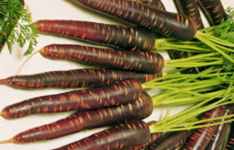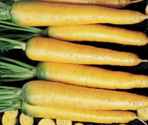 Danvers Half Long (75
days) Red -orange roots with blunted ends are uniform.
Excellent storage variety.
Danvers Half Long (75
days) Red -orange roots with blunted ends are uniform.
Excellent storage variety.
| HOME --> All Plants and Seeds INDEX --> Vegetables INDEX --> Carrots | |
| Plant and Seed Mobile Friendly Index |
Black Nebula (110 days) Pitch black 10 inch roots. Gourmet type best used for cooking or eaten fresh young.
| #9916 Packet $6.50 Approximately 500 seeds |
|
| #Bm-9916 Bulk seed 1,000 seeds $14.50 |
|
Cosmic Purple (50-65 days)
8-1/2 inch x 1-1/2 inch purple roots have yellow interior. Very
sweet.
| #4565 Packet $5.50 Approximately 500 seeds |
|
| #B1z-4565 Bulk seed 1 oz. $25.50 |
|
| #B4z-4565 Bulk seed 4oz $60.50 |
|
| #B1-4565 Bulk seed 1 lb. $165.00 |
|
 Danvers Half Long (75
days) Red -orange roots with blunted ends are uniform.
Excellent storage variety.
Danvers Half Long (75
days) Red -orange roots with blunted ends are uniform.
Excellent storage variety.
| #1245 Packet $3.50 Approximately 500 seeds |
|
| #B1z-1245 Bulk seed 1 oz. $6.50 |
|
| #B4z-1245 Bulk seed 4 oz. $15.50 |
|
| #B1-1245 Bulk seed 1 lb. $32.50 |
|
Imperator (65 days) Long tapered
roots with blunted ends have no cores and are sweet and
crisp.
| #12356 Packet $3.50 Approximately 500 seeds |
|
| #B1z-12356 Bulk seed 1 oz. $7.50 |
|
| #B4z-12356 Bulk seed 4oz $16.50 |
|
| #B1-12356 Bulk seed 1 lb. $33.50 |
|
Kuttiger (70 days) This
thick white carrot is very similar to those prized in
the vegetable markets of Europe in the 1700s.
Roots measure 6-8 inches long and have a mild flavor. Store
very well.
| #679 Packet $5.50 Approximately 100 seeds |
|
Little Finger (50-65 days) The
perfect variety for baby carrots, this early golden
orange French Nantes type has almost no core
and is great for canning, freezing, pickling,
or eating. Pick young for baby carrots
| #220 Packet $3.50 Approximately 300 seeds |
|
| #B1z-220 Bulk seed 1 oz. $10.50 |
|
| #B4z-220 Bulk seed 4oz $25.50 |
|
| #B1-220 Bulk seed 1 lb. $35.50 |
|
Lunar White (60 days) Lon white
roots are nearly coreless, are sweet and crunchy. Great for canning,
freezing, pickling, or eating fresh.
| #11246 Packet $5.50 Approximately 500 seeds |
|
| #B1z-11246 Bulk seed 1 oz. $20.50 |
|
| #B4z-11246 Bulk seed 4oz $60.50 |
|
| #B1-11246 Bulk seed 1 lb. $162.50 |
|
Parisienne (60 days) French
market carrot with short rounded roots, suitable
for any soil type, including heavy clays and shallow
soils. Provide adequate moisture throughout the growing
season for rounded shape - dry weather will cvause the roots to elongate.
| #9918 Packet $4.50 Approximately 1000 seeds |
|
| #B5m-9918 Bulk seed 5,000 seeds $12.50 |
|
 Purple Haze (65 days) Purple
skin and a bright orange interior make this one of the prettiest
carrots ever. Unlike earlier varieties bred for high beta
carotene content, this one is sweet and juicy,
with a slight spicy flavor.
Purple Haze (65 days) Purple
skin and a bright orange interior make this one of the prettiest
carrots ever. Unlike earlier varieties bred for high beta
carotene content, this one is sweet and juicy,
with a slight spicy flavor.
| #4060 Packet $6.50 Approximately 100 seeds |
|
| #B4z-4060 Bulk seed 4oz $83.33 |
|
| #B1-4060 Bulk seed 1 lb. $193.33 |
|
Scarlet Nantes (65-75
days) Good as a fresh eating carrot, this pretty carrot is
long and is nearly coreless. Good keeper.
| #428 Packet $3.50 Approximately 500 seeds |
|
| #B1z-428 Bulk seed 1 oz. $7.50 |
|
| #B4z-428 Bulk seed 4oz $14.50 |
|
| #B1-428 Bulk seed 1 lb. $27.50 |
|
 Yellowstone (75 days)
HYBRID - Yellow roots are 9 inches long and have an excellent
flavor. Stores in the ground until mid-winter.
Yellowstone (75 days)
HYBRID - Yellow roots are 9 inches long and have an excellent
flavor. Stores in the ground until mid-winter.
| #427 Packet $5.50 Approximately 500 seeds |
|
Rich Earth Carrot Mix - All
colors and sizes
| #12357 Packet $4.50 Approximately 500 seeds |
|

There is great diversity in the vegetable varieties that we offer;
which makes the general information provided only valuable as
adjustable guidelines. This may also affect your seed planting and
propagation strategies and the germination rates under your
planting conditions may vary from the seed lot test results. The
following soil temperature data is for carrots in general.
Temperatures are average daytime from planting to emergence.
Percentage is average germination rate. Days is number of days to
emergence.
41ºF x 48% x 51 days; 50ºF x 93% x 17 days; 59ºF x
95% x 10 days; 68ºF x 96% x 7 days; 77ºF x 96% x 6 days;
86ºF x 95% x 6 days; 95ºF x 74% x 9 days;
The common garden carrot is a member of the family Umbellilerae
(sny. Apiaceae) and is thought to have originated in central
Asia. Garden carrots, along with their wild counterparts
(such as Queen Anne's Lace and Ammi majis), are biennial
plants. The leaves are fine and fernlike and blooms
are white and lacey, a large bloom being made up of hundreds of
tiny individual flowers. First cultivation for their seeds
and leaves (some carrot relatives such as parsley and cilantro are
still grown for leaves and seeds), the modern carrot has been bred
for its roots, which are orange, red, white or purple depending on
variety, which are very high in beta carotene and lutein and
Vitamin A.
Carrots, like other root crops need deep fertile friable soil in
which to grow properly. Rocky and hard clay soils will
produce smaller misshapen roots. The best areas for growing
carrots would have a generous dressing of well rotted compost
forked into the ground to loosen it and add nutirients. A
dressing of manure worked into the soil the previous fall or long
enough for the manure to have decayed can be used as well, but
don't grow root crops in areas that have freshly been
manured. It can be a serious health risk. Carrots can
be sown as soon as the ground thaws and the soil worked.
Sandy or loose soils are best. If your soil is
heavy clay, work compost or peat moss and sand into the area to
break it up. Soil should drain well and a pH of 6 to
6.8. Avoid sowing in soil newly tilled on sod to reduce the
risk of wireworms attacking the roots. Rows should be laid
off about 15-24 inches apart. Plant 1 seed per inch in the
row and cover. An early sowing when the soil is still cold
should be planted at about 1/4 inch deep, when the soil is warmer,
seeds can be planted about 1/2 inch deep. Many gardeners sow a
few radish seeds with the carrots to use as a
'marker'. Many weeds are faster to emerge than carrots and
can make cultivation difficult and the radishes, which germinate
very quickly, can show where your carrots are planted and allow
better cultivation, Keep the rows watered until
germination. If it dries out, it is harder for the tiny
seedlings to emerge. After emergence, thin seedlings to 2inches
apart, 3 inches for larger root varieties. Keep the rows
weed free. Keep root shoulders covered to prevent
greening. To grow carrots for winter storage, plant in early
summer to harvest in fall.
HARVEST: Dig carrots anytime after they attain a bright
orange or size and before the roots mature to the point where they
crack and become pithy. (For storage carrots, plan for about
100 days of growth before harvet) Clean the roots and store at 32F
and 95% humidity. An old method of keeping was to bury them
in a completely dry sheltered place separated by layers of sand.
Both the young leaves and the roots of carrots eaten. More
beta carotene is released after cooking than when eating raw
carrots. .
SEED SPECS: Approximately 11,000 seeds per ounce
SEEDING RATE: 1,000 seeds per 33ft; 720,000 per acre at 30 seeds per foot in rows 24 inches apart
|
My Grandfather formed a partnership in 1928 with his brother to operate a farm on the Rio Grande. The first year he flew to New York to arrange for the orange crop to be transported to market by air. When he returned to the farm he found that his brother had received shipment of $10,000 worth of seed and had put it in an open and unwatched barn for storage. When he told me the story, he said that he had seriously considered dissolving the partnership that day. I do a lot of thinking in my Kitchen-Garden which is smaller scale than my Grandfather's farm, but I take the risk management very seriously. I pat myself on the back for being able to see the larger picture, even as the picture changes, and what was I thinking? Now it's right, pat pat. When I was first married, my beautiful young wife asked me to turn over the dirt in the back yard with my shovel so she could plant beans. I said "Don't you know that the store down the street has canned beans on sale every year." At my job wage rate we could fill another house with cans for the same time that I would spend in this garden. But she said that they tasted better and I enjoyed spending the time with her. I've been enjoying that time and that taste for a lot of years now, and just as hard as measuring quality time or a taste, is quantifying security issues and food quality health issues that I have come to appreciate. I feel productive as I hoe and pull weeds and wonder why I paid for so many years to go to the gym and why I mowed grass on this spot. But the big picture is that this garden is about my enjoyment and my health, and I have come to feel that the main health benefit is the enjoyment. So why do I fret so much when I must thin out the carrot row. Between the weather and the birds, counting on a good crop of carrots can be more risky if you don't plant a little close. But now I am doing murder. Chopping out the weeds is good farming and citizenship, but pulling a carrot hurts. Till I found from my constant study of other people's experiences, that the "weed" had value too, and I was already guilty of boticide. One year I had to leave town on important business and fretted the whole trip that the beans in the Kitchen-Garden were not going to be picked in time. But there were still plenty in the freezer. Now I have plenty of gardener friends who think the same things are important in Kitchen-Gardening methods that I do. I know more about the foods that I eat and possible good food sources are becoming more available again. Come home, feed the beans to the cows, and get over it. |
ORDER EARLY!
See TERMS
Back to VARIETY INDEX
Terms HOME
![]() If you have
arrived in someone else's frame, or can not see all of the other
information available on richfarmgarden.com Click on logo to enter
from beginning
If you have
arrived in someone else's frame, or can not see all of the other
information available on richfarmgarden.com Click on logo to enter
from beginning